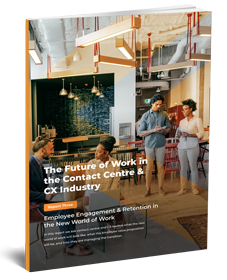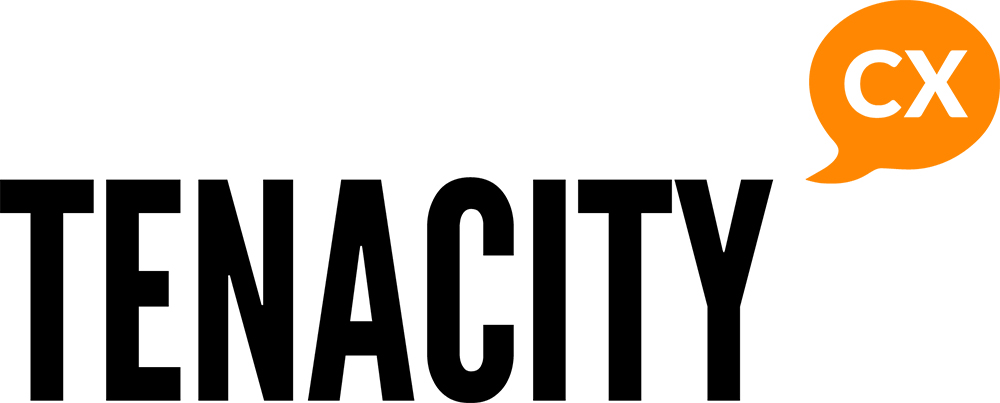The way we work has changed dramatically over the past few years, and nowhere is this more apparent than in the contact centre. A combination of factors including the pandemic lockdowns and the widespread adoption of remote working technology has driven the shift towards more flexible working conditions. As a result, contact centres have had to adapt the way they operate.
But what models are contact centres adopting today, and what are they expected to adopt in the future? And how does this tally with what employees really want? Our recent survey of 60 leading contact centre and CX leaders, as well as a separate survey of contact centre employees, provides some answers.
What working models have contact centres adopted today?
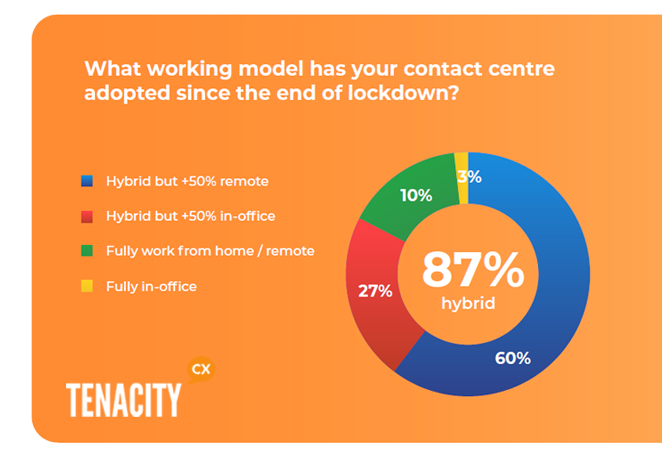 The results of the survey of contact centre and CX leaders suggest that senior managers and executives have already made a huge shift in their thinking. Barely anyone expects their staff in the office full time, or expects to go back to this model in the future. When asked what work model they had adopted since the end of lockdown, just 3% said they and their staff were working full-time from the office. Compare this to pre-pandemic levels when hybrid and remote working combined accounted for just 8% of contact centre positions.
The results of the survey of contact centre and CX leaders suggest that senior managers and executives have already made a huge shift in their thinking. Barely anyone expects their staff in the office full time, or expects to go back to this model in the future. When asked what work model they had adopted since the end of lockdown, just 3% said they and their staff were working full-time from the office. Compare this to pre-pandemic levels when hybrid and remote working combined accounted for just 8% of contact centre positions.
The findings are in line with the results of the employee survey and other market data. Around 60% of companies have adopted a hybrid model where remote work constitutes more than half of days worked, while 27% have a hybrid model which favours more days in the office than remote. Only 10% of contact centres are operating on a fully remote model.
One head of contact centres for a global insurer said, "It hasn't really changed for us since the end of lockdown, we are still doing 1 to 2 days in the office. We keep questioning what the right mix is as we need to be competitive when it comes to recruitment, so understanding what other companies are offering is key. We do tailor the days in the office for employees outside the CBD, and our geographic print has never been more diverse. We have people working in North Queensland, out of the suburbs of Adelaide, and in regional Victoria. The only place we haven't gone is Perth because of the time difference."
What working models do contact centres expect to adopt over the next few years?
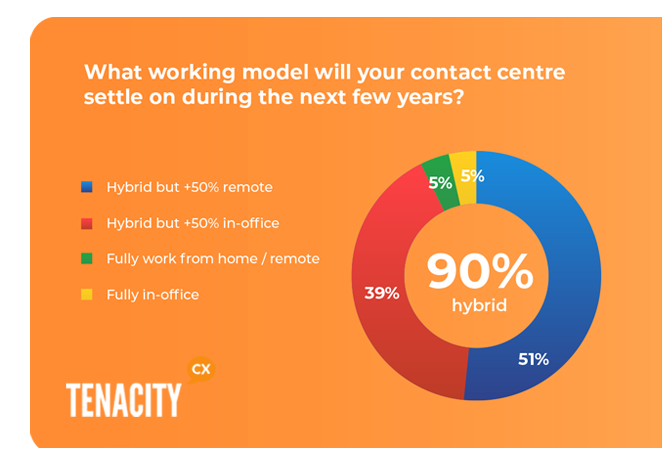 The contact centre industry leaders surveyed expect some further evolution to occur over the next few years, demonstrating that what we are experiencing right now is a transitional period.
The contact centre industry leaders surveyed expect some further evolution to occur over the next few years, demonstrating that what we are experiencing right now is a transitional period.
The number of contact centres that operate fully working from home reduces a little, but there is hardly any change in the number of contact centres that operate fully in-office, rising from 3% to an expected 5%.
This is as close to categorical proof as you can find that the once-dominant in-office model for contact centres is not going to make a Lazarus-like come-back any time soon. Hybrid is now the dominant model at over 90%. What the leaders surveyed expect to change over the next few years is the balance to tip slightly in favour of more days in the office than at home. So, while the average is currently 2 days in and 3 days out, the leaders surveyed expect this to reverse in the coming years.
A Director of Client Services for a global insurance company said, "What's changed since before the pandemic? I think people just have different things that they want to do with their lives. They always did, of course, it's just that Covid got them to think about it, and helped them realise that life could be different – it doesn't have to be the rat race all the time. It's interesting because all the older people are staying in the industry because we can give them that flexibility, and you can't get young up-and-coming talent at all."
How does this tally with what employees want?
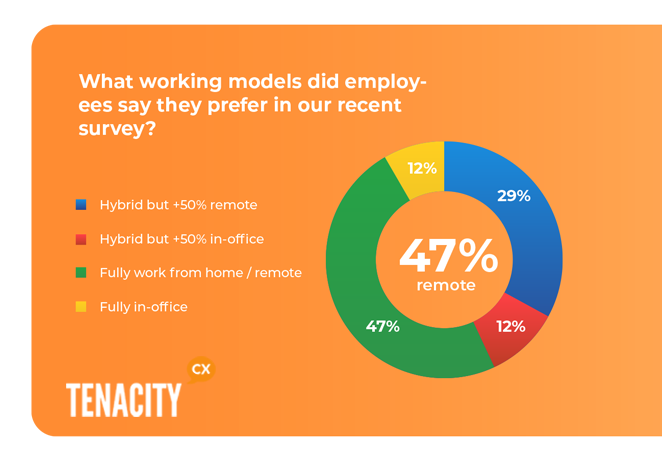 We also conducted a survey of contact centre employees, which revealed that they're pretty happy with the current set-up. However, there are discrepancies with what employers are currently offering. The first preference of a whopping 47% of employees is to work from home full time. Just 10% of contact centres are offering that right now, expected to reduce to 5% in coming years.
We also conducted a survey of contact centre employees, which revealed that they're pretty happy with the current set-up. However, there are discrepancies with what employers are currently offering. The first preference of a whopping 47% of employees is to work from home full time. Just 10% of contact centres are offering that right now, expected to reduce to 5% in coming years.
The question is whether those employees who wish to work remotely full time will accept hybrid as a compromise. In our employee survey a total of 41% were happy with some sort of hybrid working.
Interestingly, 12% of employees said their first preference was to return to the office full-time. Currently just 3% of contact centres are in the office full-time, expecting to rise to 5%. It may well be that businesses are underestimating the appetite of at least some workers to return to the office.
Employees' preferences are in sharp contrast to the concerns raised by some employers about productivity, collaboration, team building, and culture when it comes to remote working. However, it seems that employees have adapted well to the new way of working and have found that they can be just as productive, if not more so, working from home.
The survey also revealed that it's not just millennials wanting a better work-life balance, with older workers also seeing the benefits of remote working. Many are choosing to stay in the industry because of the flexibility it offers, and this could be a key factor in attracting and retaining top talent in the future.
In terms of the future, it seems that the hybrid model is here to stay. Employers are happy to continue offering remote working, but are also keen to have employees in the office for some days of the week. This allows for face-to-face interaction and collaboration, as well as a sense of company culture and community.
So, what will the future look like?
The traditional 9-5 office life is a thing of the past for contact centres, and it's not coming back any time soon. The survey results show that employers and employees alike are more-or-less happy with the current hybrid model compromise, and expect this to continue in the future.
The key for employers is to understand which of their employees want which working model. Employers of choice will no longer have blanket rules that apply to all employees, but instead will try to personalise the employee experience. We believe that’s the big opportunity for the future of work.
As the Head of Customer Operations for an Australian online bank told us; "The whole business has moved to a 50/50 model. For contact centre agents its 5 days in the office out of every 10. We let people choose when to come in, however if they need extra help and supporting them remotely isn’t working then we ask them to come in. Personally, if someone shows the right capabilities and behaviours I don’t care where they work."
Free Report
Download our latest free report "Employee Engagement and Retention in the New World of Work" for a deeper dive into these topics.
